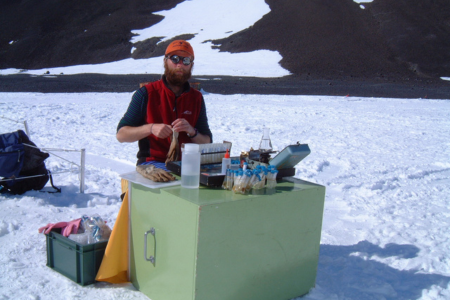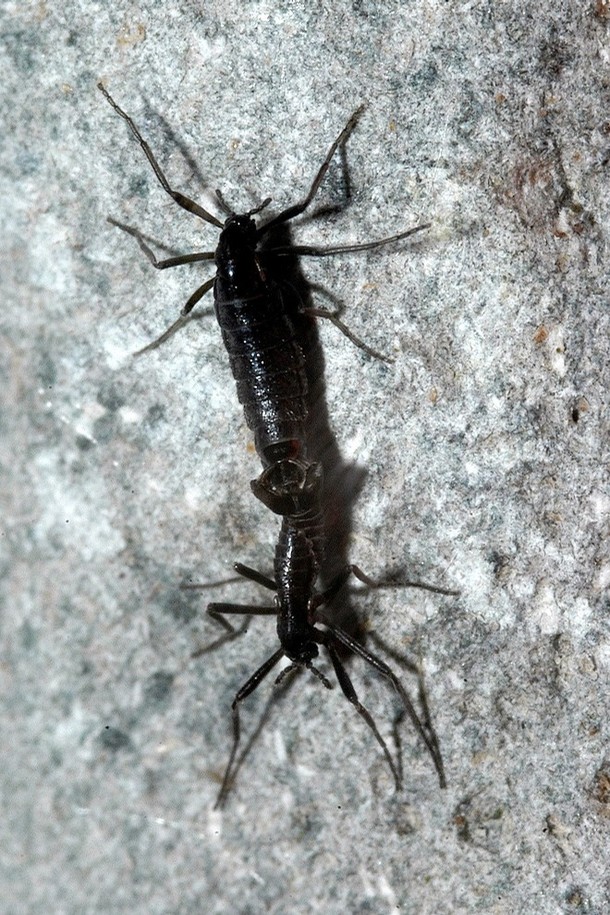Dr. Block’s first lecture was about how insects survive sub-zero temperatures. His second lecture was about the cold tolerance of the microarthropods – mites and springtails – that live in Antarctica. That lecture defined the next decade of my life – one of the main reasons I stayed at Otago University to do my PhD was so I could go to Antarctica! My core research is still about the physiology of insects that can withstand internal ice formation.

Brent Sinclair takes his nematode extractions outside the lab tent on a rare sunny day.
Cape Hallett, Antarctica, 2003. (Photo credit: K140)
Cape Hallett, Antarctica, 2003. (Photo credit: K140)
When they think of Antarctic animals, most people imagine penguins and seals. Well-informed people might bring Snow Petrels and icefish to mind. But they are all really fair(ish) weather visitors. They might breed on sea ice, or on land, but they feed at sea, and vacate the continent for large chunks of the year. To find the true Antarcticans – the only permanent inhabitants of the continent – you need to go small. Invisibly small, we find tardigrades, nematodes, and rotifers under the microscope. With a good eye, and knowing where to look, we find a handful of mites, springtails, and (the only true insect on the continent) the Antarctic Belgica antarctica. There are so few of these tiny animals that I might well have been the only PhD student in history able to identify every animal at their study site (for the record: one species of rotifer, one tardigrade, three species of nematodes, two mites, one springtail… alongside [just visiting] five birds, three seals, one primate [us], and we clocked three species of whale in as many field seasons).

Two Belgica antarctica adults (Photo credit: Tasteofcrayons)
Most of the terrestrial part of continent is covered with ice, so the only of ice-free land is in small areas around the coasts, in the McMurdo Dry Valleys, and on nunataks poking up through the ice cap. The continent has been isolated by wind and sea currents for 30 million years, so the fauna that we find today has weathered cycles of glaciation and retreat, hanging on in cold times and making hay during warm periods of high productivity. Indeed, in the McMurdo Dry Valleys, the ecosystem of soil bacteria and the nematodes that eat them is thought to be driven by legacy carbon – the remains of algal mats laid down during a time of plenty more than 10,000 years ago.
The tiny year-round Antarctic animals have to endure extraordinary environmental extremes. It’s no secret that Antarctica is cold. It’s also dry, and in areas where the rocks are dark, can be surprisingly hot at the scale relevant to the soil fauna – I’ve measured temperatures above 30 °C in places where I’d recorded -50 °C a few months previously! We know quite a lot about the strategies these animals use to survive the cold and dry – whether it’s suppressing ice formation to stay liquid tens of degrees below the temperature where they should have frozen, surviving ice formation inside the body, or simply dehydrating so there’s no ice left to freeze.
Nearly thirty years after Dr Block’s guest lectures, I’m still studying environmental physiology. On shore on the Antarctica continent, we’ll be able to take some moments to see some of the iconic Antarctic microarthropods – the springtail Cryptopygus antarcticus even featured on a postage stamp! I look forward to discussing how these strategies work, and the physiology and biochemistry that underlie them. Of course, living in Antarctica is no picnic for the marine mammals, the birds, and the sea creatures beneath the ice, so we’ll also look at the challenges they face, and how their biology – from genomes to behaviour – has evolved to let them make Antarctica home.
Brent Sinclair, Ph.D.
Professor of Biology, Western University
*I last saw Bill when I was passing through Cambridge in 2017. He’d just turned 80 (and is still going strong), and we had lunch at Wolfson College – part of which is housed in Sir Vivien Fuchs’ house, just up the road from the Scott Polar Research Institute.
Editor’s Note: You can join Brent Sinclair on our upcoming Antarctica expedition (with the Falklands and South Georgia) in late 2024. Click here to learn more.


